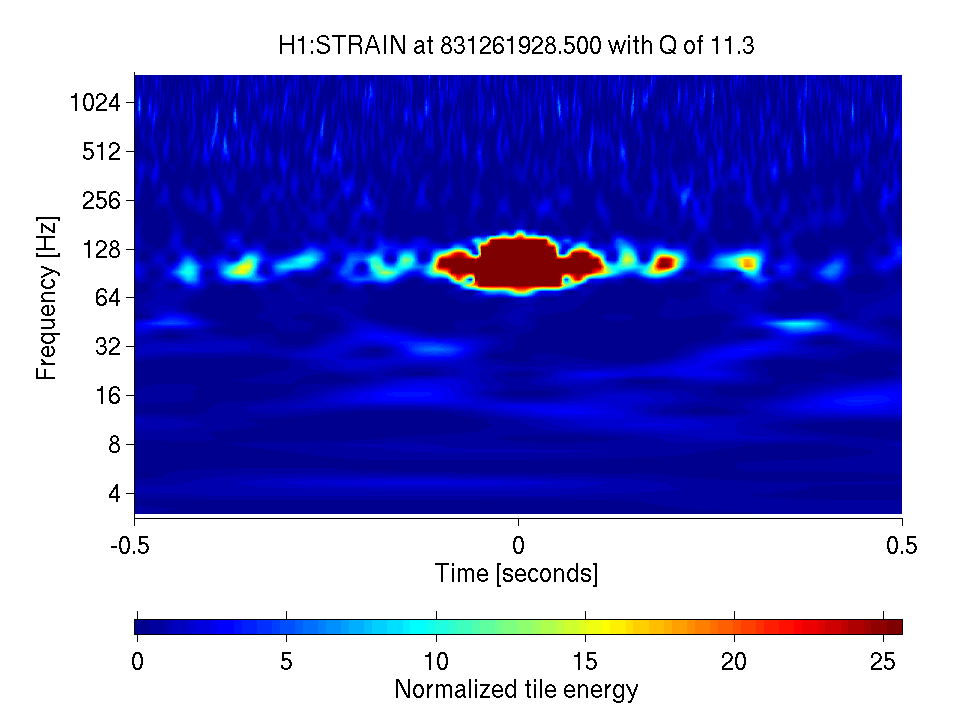S6 Burst Hardware Injections
Hardware Injections
During LIGO's 6th Science Run (S6), simulated signals were added to the LIGO detectors for testing and calibration. The simulated signals are known as hardware injections, because they were created by manipulating mirrors in the arms of the interferometers. Times of hardware injections are marked in LIGO data files by injection data quality channels. See the injection bit mask definition for details.


Burst Injections
Burst injections were added at planned times throughout S6. Burst injections were injected with the following waveforms. In addition, some notes about Burst waveform generation and naming conventions can be found on Alan Weinstein's home page.
Sine-Gaussians (sg*Q9)
The plan called for sine-Gaussians at 70, 235, 914, and 2000 Hz. An example Sine-Gaussian waveform and spectrogram can be seen in the images on this page.
Gaussian (ga*)
Gaussian waveforms with various values of the width, Tau. The number following "ga" indicates with width of the Gaussian in units of 1e-4 seconds. For example, ga0010 indicates a Gaussian waveform with a width of 1 ms.
Zwerger-Mueller (zmA3B3G1)
This is a waveform based on supernova simulations described in (Zwerger & Mueller, 1997) Catalog waveform A3B3G1, with minor tweaks to get rid of the small discontinuities at the beginning and end.
Ringdown (r2600t300)
Damped sinusoid with a frequency of 2600 Hz and a decay time of 300 ms. To avoid an abrupt beginning, it includes an exponentially growing (time scale 30 ms) sinusoid at the beginning. This waveform is rather long, so it is in a waveform file 4 seconds long. (All other waveforms are in one-second-long files.)
Cosmic string cusp (cusp220)
Generated by calling the function cuspgw.m, with a cutoff frequency of 220 Hz.
Band-limited white noise burst (wnb250bw100dt30)
These have a specified central frequency and bandwidth and have a Gaussian envelope in the time domain with a specified sigma. They use a central frequency = 250 Hz, bandwidth = 100 Hz, and sigma = 30 msec. The plan called for the signal to have two polarization components, to give somewhat different waveforms at LHO and LLO. We generated separate white-noise bursts and then took linear combinations to yield a fixed coherence of 0.7 .
Lists of Injections
Each list includes a nearly complete list of successful injections in S6 (see the "discrepancies" note below). Each row includes the following information:
- The GPS time of the injection
- The waveform name of the injection
- The hrss of the injection
- The expected SNR of the injection
- The recovered SNR of the injection, as measured by a matched filter
In addition to the tables shown above, information about injection times is available in segment lists from the Timeline application.
Timeline Segment Lists of Injections
In addition to the lists of injections above, Burst hardware injection segments may be obtained through Timeline.
- Burst Hardware Injection segments from Timeline: H1 L1
- Discrepancies between Timeline and log files noted here: H1 L1
Blind Injections
A number of burst blind injections and blind injection tests were made during S6. Their times are listed below. In addition, the approximate times of blind injections are listed in the tables of injections, with 0's listed for all other parameters.
S6 Burst blind injections or blind injection tests: 934943761 934957334 [943922598, 943922602] [944008978, 944008982] [944094881, 944094885] [944182222, 944182226] [945045802, 945045806] [945047517, 945047521] [945050104, 945050108] [945077632, 945077636] [945083196, 945083200]
Technical Details
Details about S6 hardware injections may be found on the Technical Details page.
